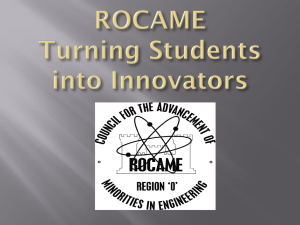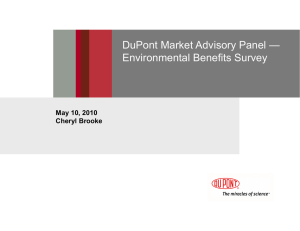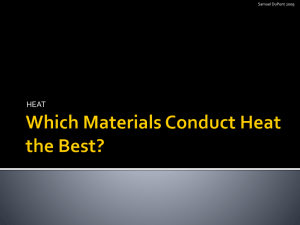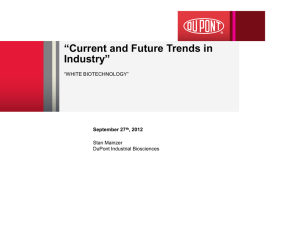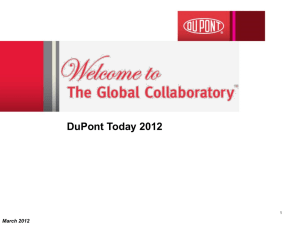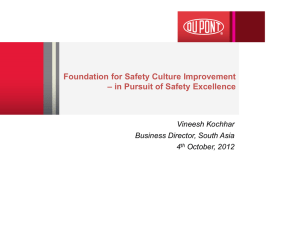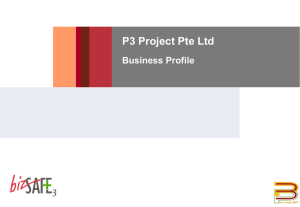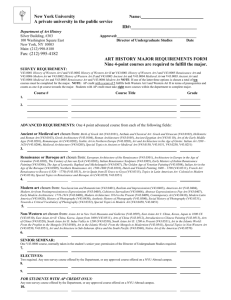New Sustainability Goals - Flexographic Pre
advertisement
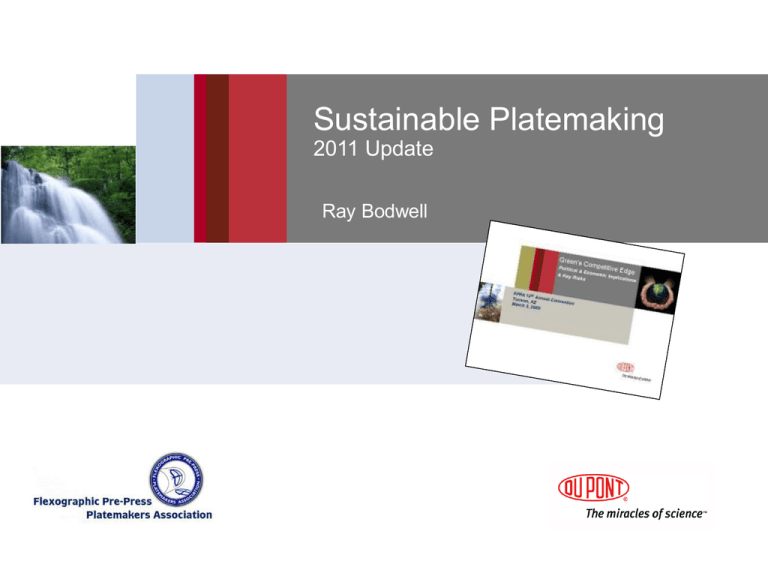
Sustainable Platemaking 2011 Update Ray Bodwell 2 Agenda Recap - Sustainability Pressures Across Value Chain DuPont & Sustainability Cyrel® and Sustainability TR3 – Return, Reuse, Recycle Drivers Across the Value Chain The Original Push: Wal-Mart 7R’s & Scorecard 7 “R’s” of Packaging by Wal-Mart 1. Remove (getting rid of unneeded packaging altogether). 2. Reduce (reducing the amount of packaging – source reduction. 3. Reuse (utilizing reusable packaging where possible). 4. Renew(able) (using renewable-resource-based packaging and renewable energy when possible). 5. Recycle(able) (using packaging materials that are made from recycled materials or can be recycled easily). 6. Revenue (not increasing the system cost of packaging). 7. Read (using packaging to educate the public about the benefits being delivered). Sustainable Packaging Scorecard To drive improvement in their packaging supply chain… • Renewable energy used (5% weighting) • Greenhouse gas emissions (life cycle) (15% weighting) • Package to product ratio (15% weighting) • Cube Utilization (15% weighting) • Transportation – Ave. distance package travels from mfg site to filling point. (10% weighting) • Recycle content (10% weighting) • Recovery Value / Recyclability of materials used (10% weighting) • Material Value (15% weighting) • Innovations to use less energy (5% weighting) 3 Drivers Across the Value Chain 4 5 Drivers Across the Value Chain 6 Global Drivers It’s no longer a question of whether or not EPR will come to America; it’s only a question of when and on whose terms.” Julian Carroll, EUROPEN EUROPEN – The European Organization for Packaging and the Environment Extended Producer Responsibility (EPR) uses political means to hold producers liable for the costs of managing their products at end of life. EPR focuses on the creation of 'cradle to cradle' recycling systems designed, financed, and managed by the producers themselves. Consumer Goods Forum (Global Packaging Project) • ISO Committee met in January, 2010 in Toronto • Develop international standards for source reduction, reuse, recycling, energy recovery, chemical recovery composting and biodegradation within 2 years. Sustainability Consortium • Administered by Arizona State & U. of Arkansas •Cradle to grave view of products & packaging • Global Index Drivers Across the Value Chain 7 Sustainable Packaging Coalition Material Use SPC Definition of Sustainable Packaging Is beneficial, safe and healthy for individuals & communities throughout its life cycle Meets market criteria for performance & cost Is sourced, manufactured, transported & recycled using renewable energy Optimizes the use of renewable or recycled source materials Is manufactured using clean production technologies & best practices Is made from materials healthy in all probable end-of-life scenarios Is physically designed to optimize materials & energy Is effectively recovered and utilized in biological and/or industrial closed loop cycles Clean Production Technologies Water Use Energy Use Material Health Community Impact Cost & Performance Worker Impact Drivers Across the Value Chain “Greening the Supply Chain” Logistics Sourcing Carbon Footprint Strategy Waste Disposal Packaging / Product Design 8 DuPont & Sustainability DuPont Mission – Sustainable Growth The creation of shareholder and societal value while we reduce the environmental footprint* along the value chains in which we operate. * DuPont defines “footprint’ as all injuries, illnesses, incidents, waste, emissions, use of water and depletable forms of raw materials and energy. 9 DuPont & Sustainability 10 DuPont “Scorecard” & Systems Thinking - 2006 Downstream Assessment Criteria 1. Greenhouse gas emissions 2. Energy consumption 3. Impact on air and water pollution 4. Material consumption & recycled content 5. Non-depletable resources inherent in our product and/or enabled in the value chain 6. Waste generation 7. Ease of disposal; hazardous waste content; recyclability and biodegradability 8. Impact on ecosystems, land use, or biological diversity 9. Impact on water quality or consumption 10.Toxicological risk to human health 11.Cradle-to-Gate Product Footprint – Material and energy use, emissions and waste associated with product manufacture and upstream processes. Up Stream Raw Material Acquisition Raw Materials Energy Down Stream Recycle Transportation Coproducts Manufacturing Air Emissions Transportation Waterborne Wastes Use/Reuse/ Maintenance Solid Wastes Waste Management 11 We Do Take Actually It Seriously DuPont Life Cycle Analysis 12 DuPont – LCA’s First objective : Second objective : Benchmark the environmental performance of Flexography versus Rotogravure printing for the flexible packaging and tag & label markets. Compare the environmental performance of solvent-based and thermal (Cyrel® FAST) flexographic plate imaging technology. Functional unit = area of printed substrate (m2) Functional unit = area of imaged plate (m2) Note : Liquid and water washable plates were not included in this study. DuPont Life Cycle Analysis 13 Definition: Life Cycle Assessment (LCA) A tool to evaluate the environmental footprint of a product or process. Evaluates all upstream and downstream products and processes. Examines materials, energy & key environmental releases. Conducted under ISO 14040-44 Critical review by qualified 3rd parties The critical review ensures that : • The methods used to carry out the LCA are consistent with this International Standard • The methods used in the LCA are scientifically and technically valid • The data used are appropriate and reasonable in relation to the study goal • The study report is transparent and consistent DuPont Life Cycle Analysis Results… 1st step : Original LCA data from 2006-2007 publication in September 2008 2nd step : Update data from 2009-2010 publication in April 2010 Reason for update. The original study was based on equipment electricity use measurements, without accounting for any idle time or variations in equipment loading. Original measurements were collected over thirteen weeks. An eight week period of continuous data collection was used for the update. 14 DuPont Life Cycle Analysis 15 0.40 9.0 0.35 8.0 7.0 0.30 6.0 0.25 5.0 0.20 4.0 0.15 3.0 0.10 2.0 0.05 1.0 0.00 0.0 Average Aligned Average Aligned Flexo Gravure Average Aligned Average Aligned Flexo Gravure Non-Renewable Energy Use (MJ per m2 of product) Greenhouse Gas Emissions (kg CO 2 e per m2 of product) Original LCA Flexography vs. Rotogravure Average 50% Savings with Flexographic Printing Flexography : • Higher viscosity inks reduces solvent use • Reduced energy & emissions for drying • Reduced substrate waste Heat Credit & Recycling Plate or Cylinder Cardboard Cores Electricity Dryer & Oxidizer Fuel Combusted VOCs Aligned Plastic Substrate Model Ink & Solvent Production Substrate Film DuPont Life Cycle Analysis Estimated Savings: Flexography vs. Gravure Changing 10 Million ft2 of Printed Substrate from Gravure to Flexographic Printing Non-renewable energy savings equivalent to 25,000 gallons of gasoline Greenhouse gas emissions savings equivalent to taking 39 average US passenger cars off the road for one year Data Source: http://www.usctcgateway.net/tool/ * Based on DuPont Life Cycle Assessment 16 DuPont Life Cycle Analysis 17 Plate Processing Workflows Solvent Process Film/Analog Laser/Digital Total Production Time: 2.5 – 4.0 hours Thermal Process Film/Analog Total Production Time: 30 – 45 mins. Laser/Digital DuPont Life Cycle Analysis 18 Average Digital Flexographic Plate Imaging Impact Cyrel® FAST has a 63% lower non-renewable energy consumption Cyrel® FAST has a 52% lower greenhouse gas emissions. 250 18 16 15.2 200 10 7.3 8 100 81 6 4 50 Solvent & Recycle 2 (kg eq. CO2 / m ) 150 Greenhouse Gas Emissions 14 12 (MJ / m2) Non-Renewable Energy Consumption 216 Light Finisher Dryer Processor & Developer Main Exposure Ablate Image Back Exposure 2 0 0 0.067 Updated Digital Solvent Average 0.067 Digital Thermal 0.067 Updated Digital Solvent Average 0.067 Digital Thermal * With DR 44 fiberweb DuPont Life Cycle Analysis 19 Updated LCA Results – Solvent vs.. Thermal Digital thermal = 63% lower energy & 53% lower ghg vs. solvent 250 18 150 10 8 100 6 4 50 2 0 0 0.067 Original Digital Solvent Average 0.067 Updated Digital Solvent Average 0.067 Digital Thermal 0.067 Original Digital Solvent Average 0.067 Updated Digital Solvent Average 0.067 Digital Thermal Figure 1: Average Digital Flexographic Plate Imaging Impact Solvent & Recycle 2 12 (kg eq. CO2 / m ) 14 Greenhouse Gas Emissions 200 (MJ / m2) Non-Renewable Energy Consumption 16 Light Finisher Dryer Processor & Fiberweb Main Exposure Ablate Image Back Exposure DuPont Life Cycle Analysis Estimated Savings: Solvent-free System Changing 100,000 ft2 of Digital Flexo Plates from Solvent Processing to Cyrel® FAST Thermal System Non-renewable energy savings equivalent to 8,750 gallons of gasoline Greenhouse gas emissions savings equivalent to taking 16 average US passenger cars off the road for one year Data Source: http://www.usctcgateway.net/tool/ * Based on DuPont Life Cycle Assessment 20 DuPont Life Cycle Analysis 21 Down-gauging: 2.0 25 1.8 1.6 20 1.4 15 1.2 1.0 0.8 10 0.6 5 0.4 0.2 0 Greenhouse Gas Emissions kg eq.CO2 / ft2 Non renewable Energy Consumption (MJ/ft2) Source Reductions through Down-gauging 0.0 0.067 Analog Solvent 0.112 Analog Solvent 0.25 Analog Solvent 0.067 Analog Solvent 0.112 Analog Solvent 0.25 Analog Solvent Based on DuPont Life Cycle Assessment Study Solvent & Recycle Processor & Fiberweb Light Finisher Main Exposure Dryer Reduces overall footprint Reduces drying time Reduces solvent use & recycling Reduces energy consumption & greenhouse gases Back Exposure Other benefits: Less board strength losses Improved graphics Supply chain reductions DuPont Life Cycle Analysis 22 Does This Really Matter? • Yes Gravure vs. Flexo is meaningful and should matter to Wal-Mart • Yes Thermal vs. solvent also impactful over time, volume and multiple SKU’s • Yes Down gauging plates has a measureable energy and CO2 savings that can also be impactful over time, volume and multiple SKU’s What about liquid and water wash plates? • We don’t make them so we didn’t measure them • All questions about energy and carbon footprint apply • Follow ISO 14040 Guidelines • Key questions around water consumption and waste water generation 23 Liquid Platemaking Question How Sustainable is it? Film Processing • Water is used in developer and fixer tanks • Used water and chemicals go down the drain when baths are replenished • Silver (heavy metals) is recovered but some traces of silver goes down the drain Platemaking • Using an increasingly precious natural resource (water) for processing and post exposure steps • Post exposure bath changed every 2-3 days • Unexposed monomer goes down the drain!! 24 Wal-Mart* and Water Use Mike Duke, President and CEO of Wal-Mart Sustainability Milestone Meeting - July 16, 2009 “You will also see some new areas that we are asking about, including water use and solid waste. These are not complicated questions, but we have never systematically asked for this kind of information before”. Why is water use efficiency important? Water efficiency issues are becoming increasingly vital: “Demand for water is doubling every 20 years, outpacing population growth twice as fast. Currently 1.3 billion people don’t have access to clean water and 2.5 billion lack proper sewage and sanitation. According to estimates, demand for freshwater will exceed the world’s supply by over 50 percent in less than 20 years.”* In light of these facts, businesses have an obligation to use water resources responsibly, and the increasing scarcity of water could raise the cost of doing business. Companies in waterintensive industries face increasing water-related physical, regulatory and reputational risks.** Have you set publically available water use reduction targets? If yes, what are those targets? DuPont Life Cycle Analysis 25 Water Considerations Aging infrastructure, climate change, strained city budgets RI Considers Raising Water Bills to Protect Supply By THE ASSOCIATED PRESS Published: October 5, 2009 Water rates in Thousand Oaks (IL) will go up in November and again in July despite the pleas of residents who asked the City Council to protect them from higher water costs. Associated Press February 5, 2008 The government projects that at least 36 states will face water shortages within five years because of rising temperatures, drought, population growth, urban sprawl, waste and excess. OCEANSIDE (CA): City eyes big boost to water, sewer rates Much of increase is to cover higher rates charged by water suppliers nctimes.com | Posted: Friday, October 9, 2009 26 But it’s The not just plate processing Waste: Goalabout is Zero Goal: Expand and develop suitable recovery, reuse or recycling options for all Plant waste & everything that we ship to Customers Recover, Reuse, Recycle 2 0 0 9 Products & Packaging Waste Manufacturing Customer Reuse EnergyfromWaste Incineration Post Manufacturing Reuse Applications PACKAGING Waste– e.g. polystyrene, gaylords, foam… PLATE Waste – Plates, Trim, CONSUMABLES – butt rolls, base & cover sheets, Binders, Polymers New Commercial Applications T O D A Y 27 What is driving the change? • US generates about 370 million tons of waste per year • Only 27% is currently recycled • 8% waste to energy • 66% Landfills • Number of Landfills in US has decreased by 75% in 20 years • 1990: 8000 Today: 1800 • Stricter landfill regulations • Increasing pressure to close or rationalize landfills • Decreasing public tolerance for landfilling • The cost for landfills will continue to increase DuPont TR3 DuPont TR3 – Return, Reuse, Recycle Disposal or Recycling Use, Reuse & Maintain Acquire Raw Materials Cradle-toGate 28 Cradle-toGrave Design & Produce Package & Distribute Sustainability Program Return all plate and packaging material for reuse or recycle Everything that leaves Parlin is returned & reused or recycled That includes: Parlin manufacturing waste – edge trim & yield losses Our customers waste – edge trim & scrap Downstream printers waste – printed plates All packaging materials – boxes, polystyrene sheets, etc. Used developer rolls Cover sheets Chemistry (still bottoms) DuPont TR3 Recycling Challenges – Who to partner with? Finding a competent, responsible recycler This is not as simple as putting the waste out on the curb! We have a cradle-to-grave stewardship responsibility It is very important to know what the recycler does with the material To understand potential end uses To understand end use safety concerns To understand any recycle process hazards We’ve chosen a recycler that is: • Very competent technically – understands polymer chemistry • Financially stable • Centrally located with our plant and customers • Has successfully satisfied all of our stewardship criteria 29 DuPont TR3 Recycling Challenges – Logistics Logistics costs must be very well managed Transportation can range from $.20 to $.60 per lb Often more expensive LTL (Less than Truckload Lot) Getting enough weight in a box is a challenge Volume is critical metric so return boxes must be full And ultimately, the material is worth only a few cents per lb. Partnered with third party logistics supplier Has been recycling some Cyrel packaging materials for 10 – 20 years Currently handles recycle for several other DuPont businesses Has a national network of warehouses and consolidation points Has relationships and favorable rates with many local trucking firms Has processes in place to arrange and manage all required transportation 30 DuPont TR3 TR3 At no cost to the Customer If the customer: Returns ~ all Cyrel® boxes in fully reusable condition Returns polystyrene in the boxes Returns all developer rolls Returns PET cover sheets Maximizes plate waste weight in a gaylord (Target is 800 lbs*) Then DuPont will: Will absorb all costs including transportation Provide empty gaylords and pallets if needed So where’s the catch? 31 DuPont TR3 Polymer Separation Requirements Cover Sheets: • Cyrel Boxes or Gaylords Raw (Unprocessed): • Carrier bins to Gaylords or Gaylords directly • Lay flat to maximize weight Fully Processed: • Carrier bins to Gaylords or Gaylords directly • Printed plates: Clean remove sticky back • Lay flat to maximize weight 32 DuPont TR3 Box Filling Requirements Shipping costs are the most expensive component of the program Shipping costs go up as weight in a box goes down It costs twice as much (per pound) to ship a 400 lb gaylord vs. an 800 lb gaylord We have targeted 800 lbs as the minimum gaylord weight Field testing customer averaging 815 lbs 33 DuPont TR3 Program Status In external evaluation > 1-year Phased roll-out going forward Initially East of the Rockies Looking to add ~ 40 more accounts in 2011 Contact your local DuPont Technical Sales Rep 34 35 Additional Resources raymond.w.bodwell@usa.dupont.com Resources – Sustainability Best Practices 36 raymond.w.bodwell@usa.dupont.com Resources – DuPont LCA Reports 37 raymond.w.bodwell@usa.dupont.com Resources 38 39 Thank you! raymond.w.bodwell@usa.dupont.com 40 Advancing Flexography
